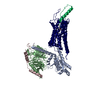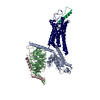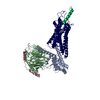+ データを開く
データを開く
- 基本情報
基本情報
| 登録情報 | データベース: PDB / ID: 7x9a | ||||||||||||
|---|---|---|---|---|---|---|---|---|---|---|---|---|---|
| タイトル | Cryo-EM structure of neuropeptide Y Y1 receptor in complex with NPY and Gi | ||||||||||||
 要素 要素 |
| ||||||||||||
 キーワード キーワード | SIGNALING PROTEIN | ||||||||||||
| 機能・相同性 |  機能・相同性情報 機能・相同性情報pancreatic polypeptide receptor activity / regulation of nerve growth factor production / peptide YY receptor activity / short-day photoperiodism / negative regulation of acute inflammatory response to antigenic stimulus / neuropeptide Y receptor activity / monocyte activation / positive regulation of dopamine metabolic process / : / positive regulation of appetite ...pancreatic polypeptide receptor activity / regulation of nerve growth factor production / peptide YY receptor activity / short-day photoperiodism / negative regulation of acute inflammatory response to antigenic stimulus / neuropeptide Y receptor activity / monocyte activation / positive regulation of dopamine metabolic process / : / positive regulation of appetite / neuropeptide Y receptor binding / intestinal epithelial cell differentiation / positive regulation of eating behavior / synaptic signaling via neuropeptide / adult feeding behavior / neuropeptide receptor activity / regulation of presynaptic cytosolic calcium ion concentration / neuropeptide hormone activity / feeding behavior / neuropeptide binding / positive regulation of cell-substrate adhesion / regulation of synaptic vesicle exocytosis / central nervous system neuron development / outflow tract morphogenesis / regulation of multicellular organism growth / G protein-coupled receptor signaling pathway, coupled to cyclic nucleotide second messenger / neuropeptide signaling pathway / FOXO-mediated transcription of oxidative stress, metabolic and neuronal genes / neuronal dense core vesicle / adenylate cyclase inhibitor activity / positive regulation of protein localization to cell cortex / negative regulation of blood pressure / T cell migration / Adenylate cyclase inhibitory pathway / D2 dopamine receptor binding / response to prostaglandin E / adenylate cyclase regulator activity / G protein-coupled serotonin receptor binding / adenylate cyclase-inhibiting serotonin receptor signaling pathway / sensory perception of pain / cellular response to forskolin / regulation of mitotic spindle organization / Peptide ligand-binding receptors / calcium channel regulator activity / Regulation of insulin secretion / locomotory behavior / positive regulation of cholesterol biosynthetic process / negative regulation of insulin secretion / G protein-coupled receptor binding / G protein-coupled receptor activity / response to peptide hormone / adenylate cyclase-inhibiting G protein-coupled receptor signaling pathway / cerebral cortex development / GABA-ergic synapse / adenylate cyclase-modulating G protein-coupled receptor signaling pathway / regulation of blood pressure / centriolar satellite / G-protein beta/gamma-subunit complex binding / Olfactory Signaling Pathway / Activation of the phototransduction cascade / glucose metabolic process / G beta:gamma signalling through PLC beta / Presynaptic function of Kainate receptors / Thromboxane signalling through TP receptor / G protein-coupled acetylcholine receptor signaling pathway / Activation of G protein gated Potassium channels / Inhibition of voltage gated Ca2+ channels via Gbeta/gamma subunits / G-protein activation / neuron projection development / terminal bouton / Prostacyclin signalling through prostacyclin receptor / G beta:gamma signalling through CDC42 / Glucagon signaling in metabolic regulation / G beta:gamma signalling through BTK / Synthesis, secretion, and inactivation of Glucagon-like Peptide-1 (GLP-1) / ADP signalling through P2Y purinoceptor 12 / photoreceptor disc membrane / Sensory perception of sweet, bitter, and umami (glutamate) taste / Glucagon-type ligand receptors / Adrenaline,noradrenaline inhibits insulin secretion / Vasopressin regulates renal water homeostasis via Aquaporins / GDP binding / Glucagon-like Peptide-1 (GLP1) regulates insulin secretion / G alpha (z) signalling events / cellular response to catecholamine stimulus / ADORA2B mediated anti-inflammatory cytokines production / ADP signalling through P2Y purinoceptor 1 / G beta:gamma signalling through PI3Kgamma / adenylate cyclase-activating dopamine receptor signaling pathway / Cooperation of PDCL (PhLP1) and TRiC/CCT in G-protein beta folding / GPER1 signaling / Inactivation, recovery and regulation of the phototransduction cascade / cellular response to prostaglandin E stimulus / heterotrimeric G-protein complex / G alpha (12/13) signalling events / sensory perception of taste / extracellular vesicle / signaling receptor complex adaptor activity / Thrombin signalling through proteinase activated receptors (PARs) / retina development in camera-type eye 類似検索 - 分子機能 | ||||||||||||
| 生物種 |  Homo sapiens (ヒト) Homo sapiens (ヒト) | ||||||||||||
| 手法 | 電子顕微鏡法 / 単粒子再構成法 / クライオ電子顕微鏡法 / 解像度: 3.2 Å | ||||||||||||
 データ登録者 データ登録者 | Tang, T. / Han, S. / Zhao, Q. / Wu, B. | ||||||||||||
| 資金援助 |  中国, 3件 中国, 3件
| ||||||||||||
 引用 引用 |  ジャーナル: Sci Adv / 年: 2022 ジャーナル: Sci Adv / 年: 2022タイトル: Receptor-specific recognition of NPY peptides revealed by structures of NPY receptors. 著者: Tingting Tang / Qiuxiang Tan / Shuo Han / Anne Diemar / Kristin Löbner / Hongyu Wang / Corinna Schüß / Victoria Behr / Karin Mörl / Mu Wang / Xiaojing Chu / Cuiying Yi / Max Keller / ...著者: Tingting Tang / Qiuxiang Tan / Shuo Han / Anne Diemar / Kristin Löbner / Hongyu Wang / Corinna Schüß / Victoria Behr / Karin Mörl / Mu Wang / Xiaojing Chu / Cuiying Yi / Max Keller / Jacob Kofoed / Steffen Reedtz-Runge / Anette Kaiser / Annette G Beck-Sickinger / Qiang Zhao / Beili Wu /    要旨: In response to three highly conserved neuropeptides, neuropeptide Y (NPY), peptide YY, and pancreatic polypeptide (PP), four G protein-coupled receptors mediate multiple essential physiological ...In response to three highly conserved neuropeptides, neuropeptide Y (NPY), peptide YY, and pancreatic polypeptide (PP), four G protein-coupled receptors mediate multiple essential physiological processes, such as food intake, vasoconstriction, sedation, and memory retention. Here, we report the structures of the human Y, Y, and Y receptors in complex with NPY or PP, and the G protein. These structures reveal distinct binding poses of the peptide upon coupling to different receptors, reflecting the importance of the conformational plasticity of the peptide in recognizing the NPY receptors. The N terminus of the peptide forms extensive interactions with the Y receptor, but not with the Y and Y receptors. Supported by mutagenesis and functional studies, subtype-specific interactions between the receptors and peptides were further observed. These findings provide insight into key factors that govern NPY signal recognition and transduction, and would enable development of selective drugs. | ||||||||||||
| 履歴 |
|
- 構造の表示
構造の表示
| 構造ビューア | 分子:  Molmil Molmil Jmol/JSmol Jmol/JSmol |
|---|
- ダウンロードとリンク
ダウンロードとリンク
- ダウンロード
ダウンロード
| PDBx/mmCIF形式 |  7x9a.cif.gz 7x9a.cif.gz | 194.6 KB | 表示 |  PDBx/mmCIF形式 PDBx/mmCIF形式 |
|---|---|---|---|---|
| PDB形式 |  pdb7x9a.ent.gz pdb7x9a.ent.gz | 147.4 KB | 表示 |  PDB形式 PDB形式 |
| PDBx/mmJSON形式 |  7x9a.json.gz 7x9a.json.gz | ツリー表示 |  PDBx/mmJSON形式 PDBx/mmJSON形式 | |
| その他 |  その他のダウンロード その他のダウンロード |
-検証レポート
| アーカイブディレクトリ |  https://data.pdbj.org/pub/pdb/validation_reports/x9/7x9a https://data.pdbj.org/pub/pdb/validation_reports/x9/7x9a ftp://data.pdbj.org/pub/pdb/validation_reports/x9/7x9a ftp://data.pdbj.org/pub/pdb/validation_reports/x9/7x9a | HTTPS FTP |
|---|
-関連構造データ
| 関連構造データ |  33069MC  7x9bC  7x9cC M: このデータのモデリングに利用したマップデータ C: 同じ文献を引用 ( |
|---|---|
| 類似構造データ | 類似検索 - 機能・相同性  F&H 検索 F&H 検索 |
- リンク
リンク
- 集合体
集合体
| 登録構造単位 | 
|
|---|---|
| 1 |
|
- 要素
要素
| #1: タンパク質 | 分子量: 43462.648 Da / 分子数: 1 / 由来タイプ: 組換発現 / 由来: (組換発現)  Homo sapiens (ヒト) / 遺伝子: NPY1R, NPYR, NPYY1 / 発現宿主: Homo sapiens (ヒト) / 遺伝子: NPY1R, NPYR, NPYY1 / 発現宿主:  Trichoplusia ni (イラクサキンウワバ) / 参照: UniProt: P25929 Trichoplusia ni (イラクサキンウワバ) / 参照: UniProt: P25929 |
|---|---|
| #2: タンパク質 | 分子量: 40414.047 Da / 分子数: 1 / Mutation: S47N, G203A, E245A, A326S / 由来タイプ: 組換発現 / 由来: (組換発現)  Homo sapiens (ヒト) / 遺伝子: GNAI1 / 発現宿主: Homo sapiens (ヒト) / 遺伝子: GNAI1 / 発現宿主:  Trichoplusia ni (イラクサキンウワバ) / 参照: UniProt: P63096 Trichoplusia ni (イラクサキンウワバ) / 参照: UniProt: P63096 |
| #3: タンパク質 | 分子量: 38744.371 Da / 分子数: 1 / 由来タイプ: 組換発現 / 由来: (組換発現)  Homo sapiens (ヒト) / 遺伝子: GNB1 / 発現宿主: Homo sapiens (ヒト) / 遺伝子: GNB1 / 発現宿主:  Trichoplusia ni (イラクサキンウワバ) / 参照: UniProt: P62873 Trichoplusia ni (イラクサキンウワバ) / 参照: UniProt: P62873 |
| #4: タンパク質 | 分子量: 7861.143 Da / 分子数: 1 / 由来タイプ: 組換発現 / 由来: (組換発現)  Homo sapiens (ヒト) / 発現宿主: Homo sapiens (ヒト) / 発現宿主:  Trichoplusia ni (イラクサキンウワバ) Trichoplusia ni (イラクサキンウワバ) |
| #5: タンパク質・ペプチド | 分子量: 4277.735 Da / 分子数: 1 / 由来タイプ: 合成 / 由来: (合成)  Homo sapiens (ヒト) / 参照: UniProt: P01303 Homo sapiens (ヒト) / 参照: UniProt: P01303 |
| 研究の焦点であるリガンドがあるか | N |
-実験情報
-実験
| 実験 | 手法: 電子顕微鏡法 |
|---|---|
| EM実験 | 試料の集合状態: PARTICLE / 3次元再構成法: 単粒子再構成法 |
- 試料調製
試料調製
| 構成要素 |
| ||||||||||||||||||||||||
|---|---|---|---|---|---|---|---|---|---|---|---|---|---|---|---|---|---|---|---|---|---|---|---|---|---|
| 由来(天然) | 生物種:  Homo sapiens (ヒト) Homo sapiens (ヒト) | ||||||||||||||||||||||||
| 由来(組換発現) | 生物種:  Trichoplusia ni (イラクサキンウワバ) Trichoplusia ni (イラクサキンウワバ) | ||||||||||||||||||||||||
| 緩衝液 | pH: 7.5 | ||||||||||||||||||||||||
| 試料 | 包埋: NO / シャドウイング: NO / 染色: NO / 凍結: YES | ||||||||||||||||||||||||
| 急速凍結 | 凍結剤: ETHANE |
- 電子顕微鏡撮影
電子顕微鏡撮影
| 実験機器 |  モデル: Titan Krios / 画像提供: FEI Company |
|---|---|
| 顕微鏡 | モデル: FEI TITAN KRIOS |
| 電子銃 | 電子線源:  FIELD EMISSION GUN / 加速電圧: 300 kV / 照射モード: FLOOD BEAM FIELD EMISSION GUN / 加速電圧: 300 kV / 照射モード: FLOOD BEAM |
| 電子レンズ | モード: BRIGHT FIELD / 最大 デフォーカス(公称値): 2300 nm / 最小 デフォーカス(公称値): 1300 nm |
| 撮影 | 電子線照射量: 70 e/Å2 フィルム・検出器のモデル: GATAN K3 BIOQUANTUM (6k x 4k) |
- 解析
解析
| ソフトウェア |
| ||||||||||||||||||||||||
|---|---|---|---|---|---|---|---|---|---|---|---|---|---|---|---|---|---|---|---|---|---|---|---|---|---|
| CTF補正 | タイプ: NONE | ||||||||||||||||||||||||
| 3次元再構成 | 解像度: 3.2 Å / 解像度の算出法: FSC 0.143 CUT-OFF / 粒子像の数: 423400 / 対称性のタイプ: POINT | ||||||||||||||||||||||||
| 精密化 | 交差検証法: NONE 立体化学のターゲット値: GeoStd + Monomer Library + CDL v1.2 | ||||||||||||||||||||||||
| 原子変位パラメータ | Biso mean: 92.41 Å2 | ||||||||||||||||||||||||
| 拘束条件 |
|
 ムービー
ムービー コントローラー
コントローラー





 PDBj
PDBj
































